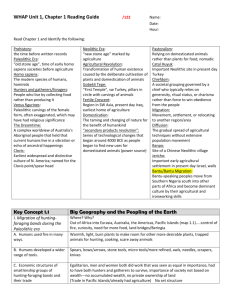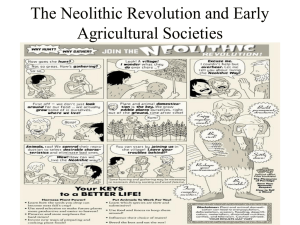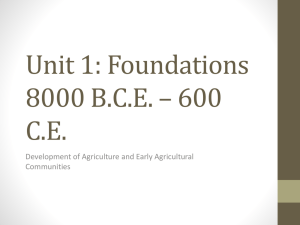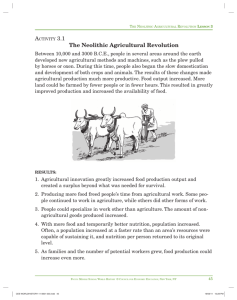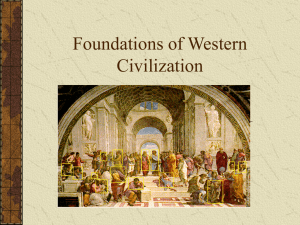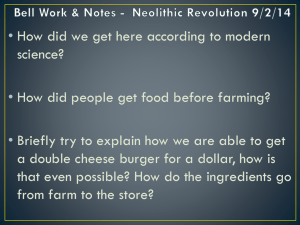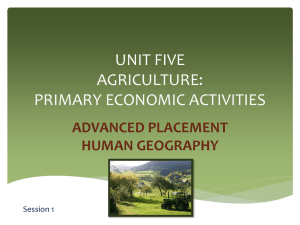Lesson 3 Slides - MSH - Council for Economic Education
advertisement
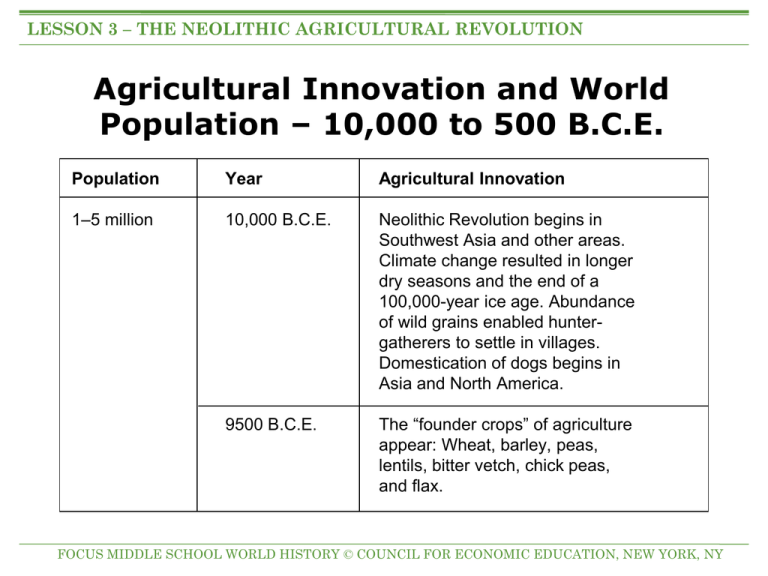
LESSON 3 – THE NEOLITHIC AGRICULTURAL REVOLUTION Agricultural Innovation and World Population – 10,000 to 500 B.C.E. Population Year Agricultural Innovation 1–5 million 10,000 B.C.E. Neolithic Revolution begins in Southwest Asia and other areas. Climate change resulted in longer dry seasons and the end of a 100,000-year ice age. Abundance of wild grains enabled huntergatherers to settle in villages. Domestication of dogs begins in Asia and North America. 9500 B.C.E. The “founder crops” of agriculture appear: Wheat, barley, peas, lentils, bitter vetch, chick peas, and flax. FOCUS MIDDLE SCHOOL WORLD HISTORY © COUNCIL FOR ECONOMIC EDUCATION, NEW YORK, NY LESSON 3 – THE NEOLITHIC AGRICULTURAL REVOLUTION Agricultural Innovation and World Population – 10,000 to 500 B.C.E. Population Year Agricultural Innovation 8–10 million 8000 – 6000 B.C.E. Nomadic hunter-gatherers begin to grow food and domesticate animals: Rice in China, 7500 B.C.E. Squash in Mexico, 7000 B.C.E. Wheat in Mesopotamia, 8500 B.C.E. Cattle in SW Asia and India, 7000 B.C.E. Domestication of sheep, goats, and pigs begins in SW Asia. Irrigation systems introduced. 7000 – 6000 B.C.E. Domestication of cattle begins in SW Asia, Pakistan, and India. FOCUS MIDDLE SCHOOL WORLD HISTORY © COUNCIL FOR ECONOMIC EDUCATION, NEW YORK, NY LESSON 3 – THE NEOLITHIC AGRICULTURAL REVOLUTION Agricultural Innovation and World Population – 10,000 to 500 B.C.E. Population Year Agricultural Innovation 8–10 million 6000 – 3000 B.C.E. A wooden plow, the “ard,” used in Mesopotamia and Egypt. Permanent villages established in the Fertile Crescent. Farming on the banks of the Nile River. 5000 – 3000 B.C.E. Domestication begins of horses in Ukraine, donkeys in Egypt, and water buffalo in China. Corn (maize) production in Mexico. FOCUS MIDDLE SCHOOL WORLD HISTORY © COUNCIL FOR ECONOMIC EDUCATION, NEW YORK, NY LESSON 3 – THE NEOLITHIC AGRICULTURAL REVOLUTION Agricultural Innovation and World Population – 10,000 to 500 B.C.E. Population Year Agricultural Innovation 14–20 million 3000 B.C.E. Irrigation systems and dams built on the Nile River. Crop production increases trade and spread of agriculture. Potatoes domesticated in Peru. 2000 B.C.E. Iron plow developed in China. 50 million 1000 B.C.E. Manure used as fertilizer. Iron plows widely used in China and SW Asia. 100 million 500 B.C.E. “Mouldboard” plow with a V-shaped iron cutting wedge developed in China. FOCUS MIDDLE SCHOOL WORLD HISTORY © COUNCIL FOR ECONOMIC EDUCATION, NEW YORK, NY LESSON 3 – THE NEOLITHIC AGRICULTURAL REVOLUTION The Ard Plow FOCUS MIDDLE SCHOOL WORLD HISTORY © COUNCIL FOR ECONOMIC EDUCATION, NEW YORK, NY LESSON 3 – THE NEOLITHIC AGRICULTURAL REVOLUTION The Ard Plow in Use FOCUS MIDDLE SCHOOL WORLD HISTORY © COUNCIL FOR ECONOMIC EDUCATION, NEW YORK, NY LESSON 3 – THE NEOLITHIC AGRICULTURAL REVOLUTION World Population Growth Years Elapsed Year World Population --10,000 1,800 130 30 15 12 12 13 13 10,000 B.C.E. 1 C.E.1 18002 1930 1960 1975 1987 1999 2012 2025 5–10 Million 170 Million 1 Billion 2 Billion 3 Billion 4 Billion 5 Billion 6 Billion 7 Billion* 8 Billion* Source: U.S. Census Bureau, International Data Base 1 Neolithic Revolution 2 Industrial Revolution FOCUS MIDDLE SCHOOL WORLD HISTORY © COUNCIL FOR ECONOMIC EDUCATION, NEW YORK, NY LESSON 3 – THE NEOLITHIC AGRICULTURAL REVOLUTION The Fertile Crescent FOCUS MIDDLE SCHOOL WORLD HISTORY © COUNCIL FOR ECONOMIC EDUCATION, NEW YORK, NY

